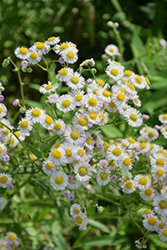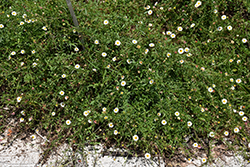It's all about ...
plants

Philidelphia Fleabane
Erigeron philadelphicus
Plant Height: 12 inches
Flower Height: 30 inches
Spread: 24 inches
Sunlight:
![]()
![]()
Hardiness Zone: 2a
Other Names: Common Fleabane Daisy
Description:
A widespread North American native plant presenting a low mound of narrow, bright green leaves; white daisy flowers with threadlike petals and sunny yellow centers emerge from pale pink buds in early summer; great for wildflower gardening and naturalizing
Ornamental Features
Philidelphia Fleabane has masses of beautiful panicles of white daisy flowers with yellow eyes at the ends of the stems from early to mid summer, which emerge from distinctive shell pink flower buds, and which are most effective when planted in groupings. The flowers are excellent for cutting. Its narrow leaves remain light green in colour throughout the season.
Landscape Attributes
Philidelphia Fleabane is an herbaceous perennial with an upright spreading habit of growth. Its relatively fine texture sets it apart from other garden plants with less refined foliage.
This is a relatively low maintenance plant, and is best cleaned up in early spring before it resumes active growth for the season. It is a good choice for attracting bees and butterflies to your yard, but is not particularly attractive to deer who tend to leave it alone in favor of tastier treats. Gardeners should be aware of the following characteristic(s) that may warrant special consideration;
- Self-Seeding
Philidelphia Fleabane is recommended for the following landscape applications;
- Mass Planting
- Rock/Alpine Gardens
- Border Edging
- General Garden Use
- Naturalizing And Woodland Gardens
Planting & Growing
Philidelphia Fleabane will grow to be about 12 inches tall at maturity extending to 30 inches tall with the flowers, with a spread of 24 inches. It grows at a fast rate, and under ideal conditions can be expected to live for approximately 3 years. As an herbaceous perennial, this plant will usually die back to the crown each winter, and will regrow from the base each spring. Be careful not to disturb the crown in late winter when it may not be readily seen!
This plant does best in full sun to partial shade. It is very adaptable to both dry and moist growing conditions, but will not tolerate any standing water. It is considered to be drought-tolerant, and thus makes an ideal choice for a low-water garden or xeriscape application. This plant does not require much in the way of fertilizing once established. It is not particular as to soil pH, but grows best in poor soils. It is somewhat tolerant of urban pollution. This species is native to parts of North America..

